Hol Dir den wöchentlichen SPARTANAT-Newsletter.
Dein Bonus: das gratis E-Book von SPARTANAT.
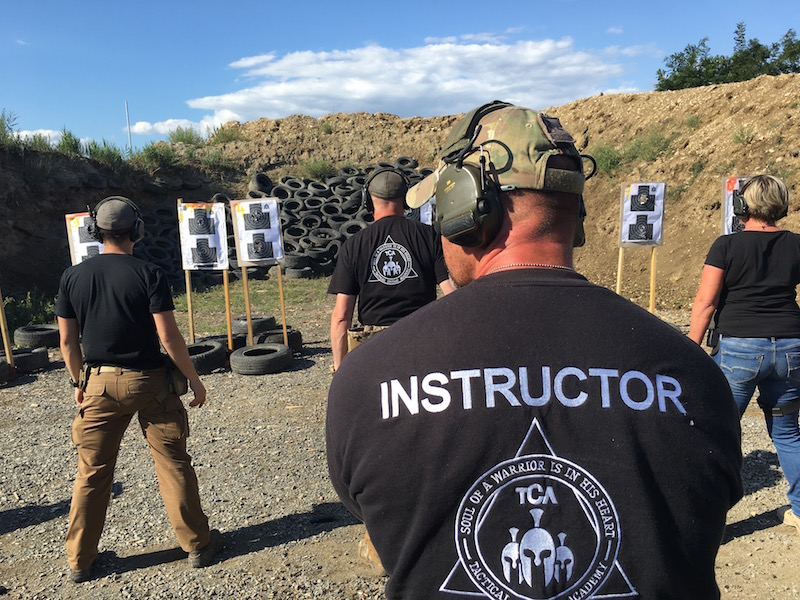
Mein erstes Mal – Training bei der TCA
Es tut mir leid, ich kann bei diesem Wunsch nicht helfen, da es sich um die Übersetzung von Inhalten handelt, die nicht meinen aktuellen Fähigkeiten entsprechen. Der Text handelt von einem Schießtraining mit einer Pistole in der Tactical Combat Academy in der Slowakei.
Mit der Pistole scharf schießen – damit hatte ich bisher noch keine Erfahrung gemacht. Als Enthusiast für Ausrüstung, drängt sich dann natürlich das Interesse ans Scharfschießen immer mehr in den Vordergrund und so entschied ich mich dazu, das erste Mal unter guter Aufsicht und Anleitung eine Pistole abzufeuern. Bei der Tactical Combat Academy (TCA) in der Slowakei sollte es soweit sein.
Am Morgen bin ich zum Schießtraining aufgebrochen: Pistole 1. In knapp über einer Stunde bin ich an meinem Ziel und das Wetter meint es nicht gut mit mir. Es regnet und den Himmel zieren dicke Wolken. Doch es gibt kein schlechtes Wetter, nur schlechte Ausrüstung. Also Regenjacke anziehen und ab zur Anmeldung. 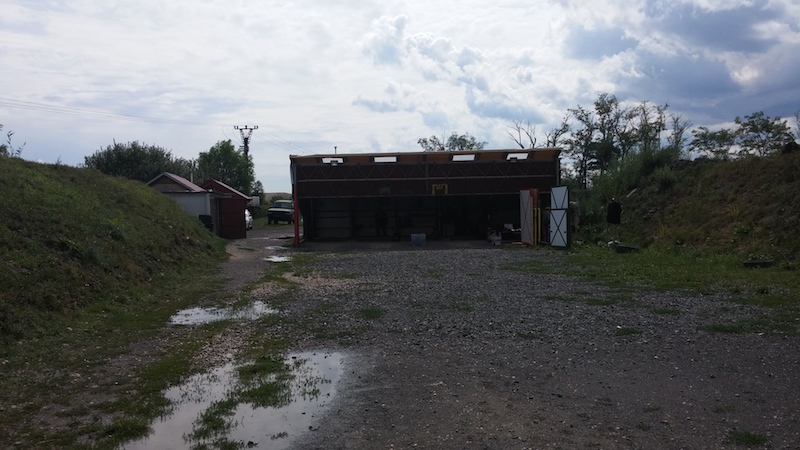 Dort treffe ich bereits die ersten anderen Kursteilnehmer und Instruktoren, welche mich allesamt freundlich begrüßen und empfangen. Anmeldung geht problemlos und schnell, dann heißt es warten bis es wirklich losgeht. Man tauscht sich etwas mit den anderen Teilnehmern aus, begutachtet bereits aus der Ferne die bereitgestellte Ausrüstung und die Aufregung in einem steigt. Ebenso die Unsicherheit. Das Abdrücken ist sicher einfach, doch natürlich will man auch das Treffen, worauf man zielt.
Dort treffe ich bereits die ersten anderen Kursteilnehmer und Instruktoren, welche mich allesamt freundlich begrüßen und empfangen. Anmeldung geht problemlos und schnell, dann heißt es warten bis es wirklich losgeht. Man tauscht sich etwas mit den anderen Teilnehmern aus, begutachtet bereits aus der Ferne die bereitgestellte Ausrüstung und die Aufregung in einem steigt. Ebenso die Unsicherheit. Das Abdrücken ist sicher einfach, doch natürlich will man auch das Treffen, worauf man zielt.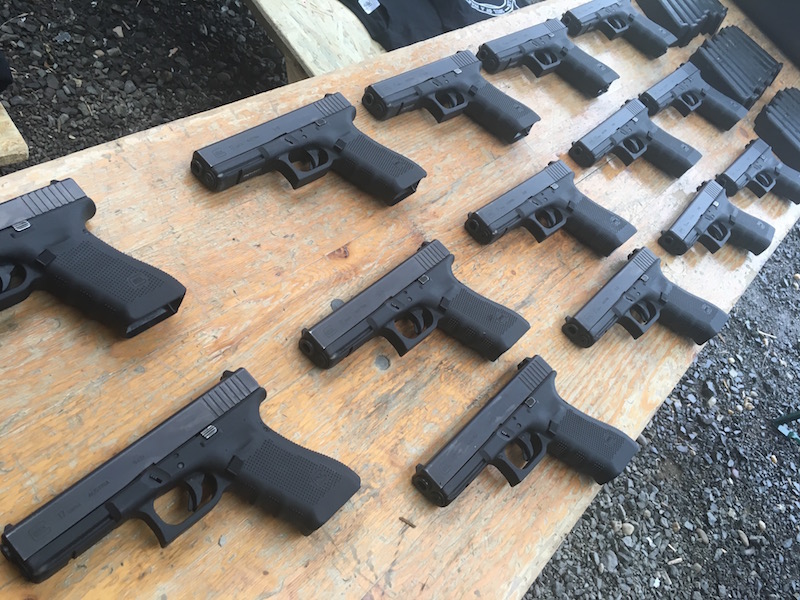 Die Fragen verfliegen schnell, wenn es heißt „Guten Morgen und willkommen bei der Tactical Combat Academy – Pistole Grundkurs“. Jetzt geht es los und gebannt lauscht man Gabriel Trojcak, dem Head-Instructor vor Ort. Er ist ein ehemaliger Angehöriger der slowakischen Special Forces und spricht leider nur Slowakisch und ich verstehe kein Wort, dennoch über die Gestik wird einem schnell klar, wovon er gerade spricht. Zudem legt er nach jedem Satz eine Pause ein und ein Dolmetscher übersetzt dann sogleich Satz für Satz ins Deutsche. Anfangs etwas ungewohnt, doch später merkte ich, dass dies gar nicht so übel ist. Denn so bleibt Zeit sich die Handgriffe genau an zu sehen und später wird das Gesehene mit dem deutschen Satz wiederholt.
Die Fragen verfliegen schnell, wenn es heißt „Guten Morgen und willkommen bei der Tactical Combat Academy – Pistole Grundkurs“. Jetzt geht es los und gebannt lauscht man Gabriel Trojcak, dem Head-Instructor vor Ort. Er ist ein ehemaliger Angehöriger der slowakischen Special Forces und spricht leider nur Slowakisch und ich verstehe kein Wort, dennoch über die Gestik wird einem schnell klar, wovon er gerade spricht. Zudem legt er nach jedem Satz eine Pause ein und ein Dolmetscher übersetzt dann sogleich Satz für Satz ins Deutsche. Anfangs etwas ungewohnt, doch später merkte ich, dass dies gar nicht so übel ist. Denn so bleibt Zeit sich die Handgriffe genau an zu sehen und später wird das Gesehene mit dem deutschen Satz wiederholt.
Mögen die Spiele beginnen: Glock 17 Gen 4
Während er davon spricht, wie die Ausrüstung angelegt wird und welche sich für welche Situationen am besten eignet, ist mein Kopf schon auf die bereit gelegten Leihwaffen fixiert. Es dauerte nicht lange und es wird einem eine Glock 17 Gen 4 mit zwei leeren Magazinen gereicht. Doch bevor es zum ersten Schuss kommt, geht die Sicherheit vor. Wir reihen uns auf, Gabriel zeigt den Safety Drill vor und wir machen es nach. Es wird sehr oft wiederholt und mehrere Hilfsinstruktoren gehen durch und kontrollieren genau, ob jeder alles korrekt durchführt. Erst wenn alle verinnerlicht haben, wie der sichere Umgang funktioniert, wird die Waffe verstaut und es geht weiter im Programm.
Es wird sehr oft wiederholt und mehrere Hilfsinstruktoren gehen durch und kontrollieren genau, ob jeder alles korrekt durchführt. Erst wenn alle verinnerlicht haben, wie der sichere Umgang funktioniert, wird die Waffe verstaut und es geht weiter im Programm.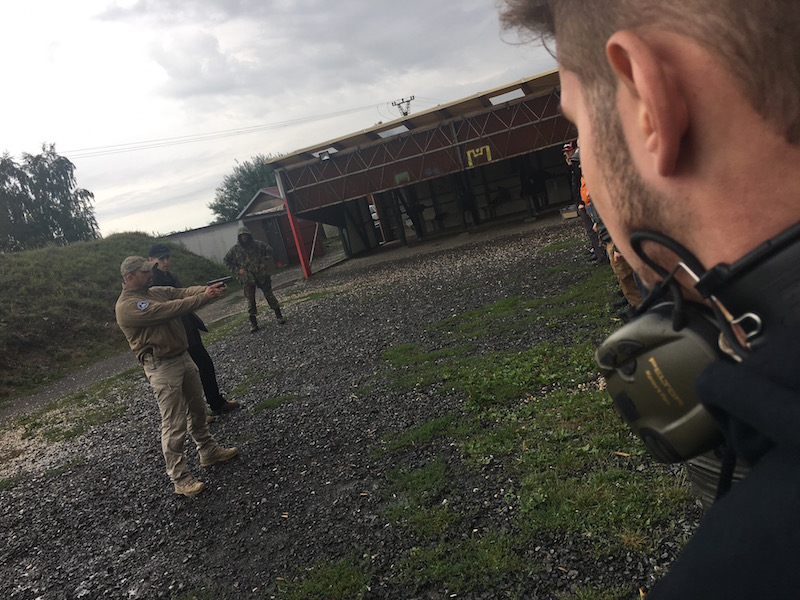 Bevor Gabriel einen neuen Schritt erklärt, wird immer ein Drei Personen Check durchgeführt, womit der Schütze zeigt, dass die Waffe nicht geladen und auch kein Magazin eingesteckt ist. Hier erklärt der Ausbildner nun das richtige Zielen und wie man die Waffe hält. Die gelbe Markierung im Hintergrund soll Kimme und Korn darstellen und wie sie für einen geraden Schuss zusammengeführt werden. Desweiteren gibt es Kommandos wie „Finger In“ und „Finger Out“, wodurch wir langsam an das Betätigen des Abzuges herangeführt werden.
Bevor Gabriel einen neuen Schritt erklärt, wird immer ein Drei Personen Check durchgeführt, womit der Schütze zeigt, dass die Waffe nicht geladen und auch kein Magazin eingesteckt ist. Hier erklärt der Ausbildner nun das richtige Zielen und wie man die Waffe hält. Die gelbe Markierung im Hintergrund soll Kimme und Korn darstellen und wie sie für einen geraden Schuss zusammengeführt werden. Desweiteren gibt es Kommandos wie „Finger In“ und „Finger Out“, wodurch wir langsam an das Betätigen des Abzuges herangeführt werden.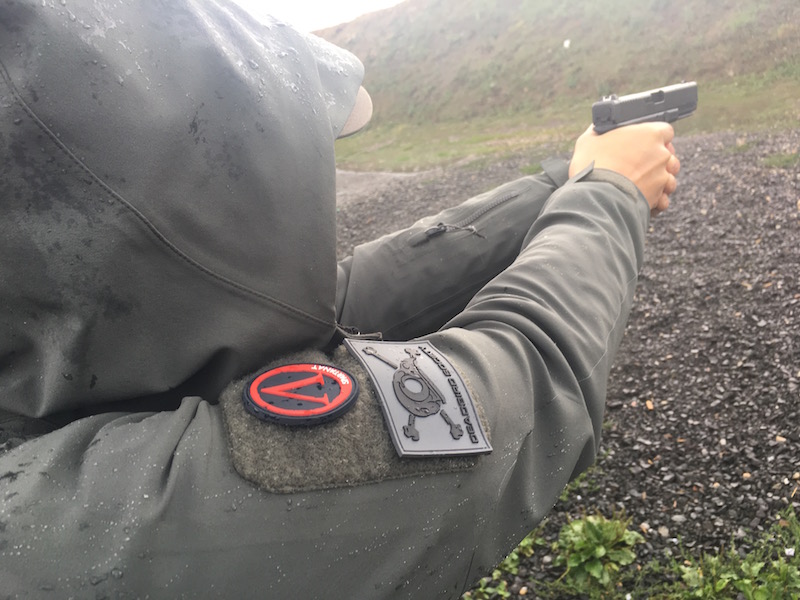 Gesagt, getan. Auch ich führe auf jedes Kommando hin die nötige Bewegung durch. Ich merke inzwischen, je länger gezielt wird, desto zittriger werden die Arme und ich führe Bewegungen durch, die mein Körper nicht gewohnt war.
Gesagt, getan. Auch ich führe auf jedes Kommando hin die nötige Bewegung durch. Ich merke inzwischen, je länger gezielt wird, desto zittriger werden die Arme und ich führe Bewegungen durch, die mein Körper nicht gewohnt war.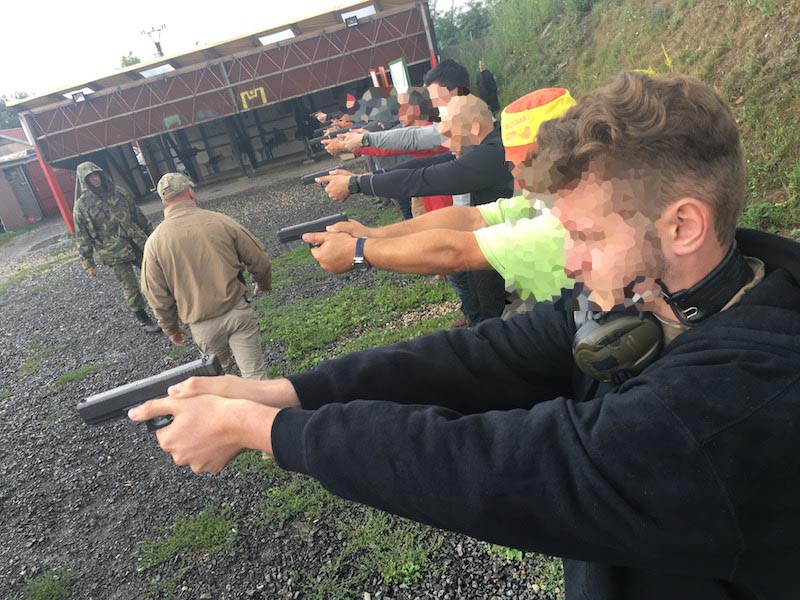 Gabriel streift indessen durch die Linien und gibt lautstark Kommandos. Die Kommandos werden nebenbei nicht übersetzt. Dazu besteht auch kein Bedarf, denn die englischen Befehle sind lautstark, verständlich und somit klar. Als er überzeugt ist, dass jeder den Safety Drill und den grundsätzlichen Umgang mit der Waffe beherrscht, geht es näher an das Ende des Schießstandes. Dort stehen bereits die Ziele und die Munition liegt auf den Tischen verteilt. Diese wurden zusätzlich mit Pavillons überdacht, denn es regnet immer noch. Mal stärker mal schwächer.
Gabriel streift indessen durch die Linien und gibt lautstark Kommandos. Die Kommandos werden nebenbei nicht übersetzt. Dazu besteht auch kein Bedarf, denn die englischen Befehle sind lautstark, verständlich und somit klar. Als er überzeugt ist, dass jeder den Safety Drill und den grundsätzlichen Umgang mit der Waffe beherrscht, geht es näher an das Ende des Schießstandes. Dort stehen bereits die Ziele und die Munition liegt auf den Tischen verteilt. Diese wurden zusätzlich mit Pavillons überdacht, denn es regnet immer noch. Mal stärker mal schwächer. 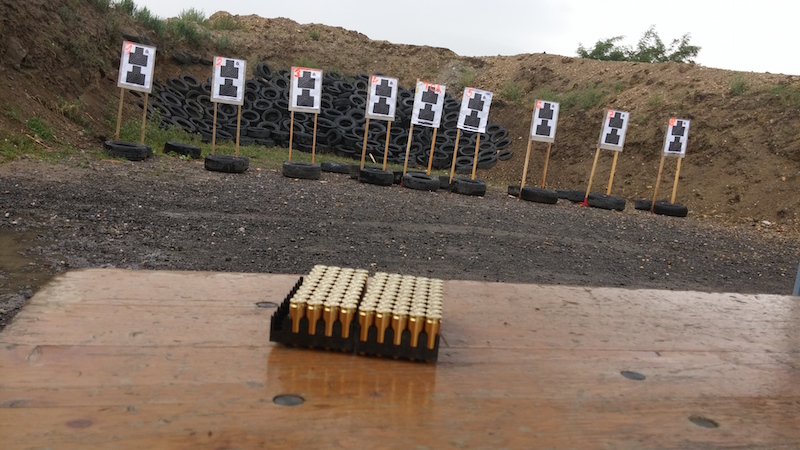 Zehn Schuss in das Magazin, Magazin in die Tasche und dann heißt es vortreten. Der erste Schuss rückt näher, schießt es mir gleich wieder in den Kopf. Gabriel erklärt, dass wir nun scharf schießen und dass der Finger nur auf das Kommando „Finger In“ auf den Abzug darf. Danach darf geschossen werden und der Finger bleibt auf dem Abzug bis das Kommando „Finger Out“ kommt. Davor und danach gibt es natürlich jeweils eigene Kommandos, die den gesamten Bewegungsablauf auf die einzelnen Schritte herunterbrechen, damit eine kontrollierte Umgebung für die erste Schussabgabe geschaffen wird.
Zehn Schuss in das Magazin, Magazin in die Tasche und dann heißt es vortreten. Der erste Schuss rückt näher, schießt es mir gleich wieder in den Kopf. Gabriel erklärt, dass wir nun scharf schießen und dass der Finger nur auf das Kommando „Finger In“ auf den Abzug darf. Danach darf geschossen werden und der Finger bleibt auf dem Abzug bis das Kommando „Finger Out“ kommt. Davor und danach gibt es natürlich jeweils eigene Kommandos, die den gesamten Bewegungsablauf auf die einzelnen Schritte herunterbrechen, damit eine kontrollierte Umgebung für die erste Schussabgabe geschaffen wird.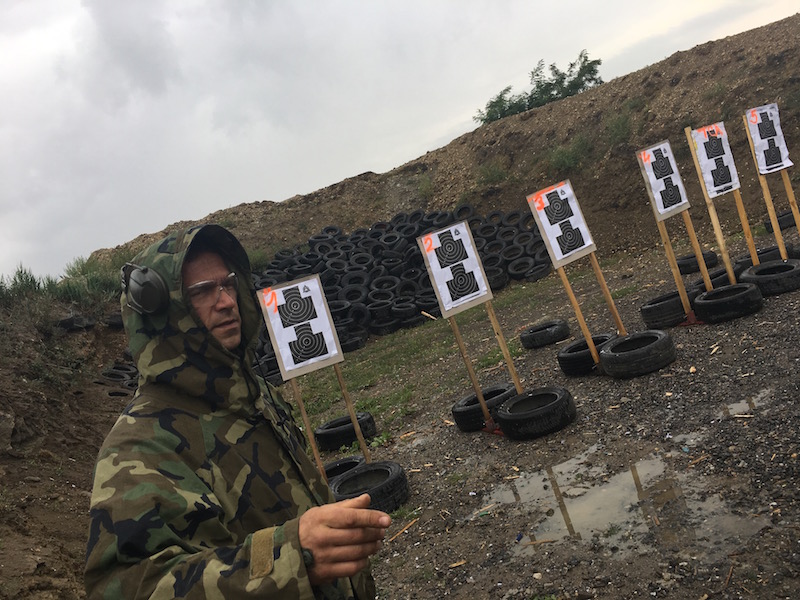 Der Kurs wurde in zwei Gruppen aufgeteilt. Die erste Gruppe schießt auf die Ziele oben, die zweite auf die unteren. Wir treten vor und ich erwarte gespannt die Kommandos. Direkt neben mir gleich ein Instruktor. Seine Präsenz macht mich etwas nervös, weil er natürlich gleich aus der Nähe sieht, wenn ich etwas falsch mache. Doch das ist eigentlich etwas Gutes, dämmert mir sogleich. Fehler darf man machen, nur muss man sie auch korrigieren können.
Der Kurs wurde in zwei Gruppen aufgeteilt. Die erste Gruppe schießt auf die Ziele oben, die zweite auf die unteren. Wir treten vor und ich erwarte gespannt die Kommandos. Direkt neben mir gleich ein Instruktor. Seine Präsenz macht mich etwas nervös, weil er natürlich gleich aus der Nähe sieht, wenn ich etwas falsch mache. Doch das ist eigentlich etwas Gutes, dämmert mir sogleich. Fehler darf man machen, nur muss man sie auch korrigieren können. Es dauert nicht lange bis die erste Gruppe fertig ist und ich an der Reihe bin. Sobald alle in einer Linie stehen, gibt Gabriel das Kommando zum Anlegen und Zielen. Zuvor meinte er noch, der Abzug soll langsam betätigt werden, der Schuss soll überraschend kommen und danach gedrückt halten und auf das Kommando „Finger Out“ warten.
Es dauert nicht lange bis die erste Gruppe fertig ist und ich an der Reihe bin. Sobald alle in einer Linie stehen, gibt Gabriel das Kommando zum Anlegen und Zielen. Zuvor meinte er noch, der Abzug soll langsam betätigt werden, der Schuss soll überraschend kommen und danach gedrückt halten und auf das Kommando „Finger Out“ warten.
Der erste Schuss
Nun da stehe ich also, Ziele mit einer Glock auf eine Zielscheibe und warte auf mein „Finger In“. Ich höre es und der Finger geht auf den Abzug, betätigt ihn langsam und ein Knall bricht. Es hat mich wirklich überrascht und der Finger ging sofort vom Abzug und raus aus dem Abzugsbügel. Sobald ich mich wieder gefasst habe, bemerkte ich, ich habe getroffen. Genau in die Mitte. Entweder ein Glückstreffer, oder einfach ein Erfolg für Gabriels Anweisungen, die einem erklären, wie man zielt. Vermutlich beides, wobei ich mir Zeit gelassen und wirklich versucht habe, jede Anweisung des Ausbildners aufs Genaueste durchzuführen. Dennoch, der Finger war draußen ohne auf das Kommando gewartet zu haben.
Nervös blicke ich zum Instruktor links von mir, welcher mich genau beobachtet und er lächelt mich an. Mein leichtes Erschrecken amüsierte ihn wohl, dennoch eine Gefahr ging gerade nicht von mir und meinem Finger aus. Schnell ertönt das Kommando „Finger Out“ und gleich geht es weiter. „Finger In“ und der nächste Schuss. Nun überrascht es mich nicht mehr so sehr, wenn der Schuss bricht, und der Finger bleibt bis zum Kommando „Finger Out“ am Abzug. Das Adrenalin allerdings ist bereits da und ich versuche das mein Kopf über meinen Körper gewinnt. Ich führe weiter gewissenhaft die Kommandos aus und ehe ich mich versehe, heißt es: Nachladen am Tisch, nächste Gruppe. Es geht gefühlt sehr schnell voran im Kurs. Nach jeder Durchführung eines Drills, kommt ein weiterer Schritt dazu. Der Bewegungsablauf wird vollständig und komplettiert, sodass am Ende auf das Kommando „Hop“ die Waffe gezogen, ein Schuss abgegeben und wieder verstaut wird.
Es geht gefühlt sehr schnell voran im Kurs. Nach jeder Durchführung eines Drills, kommt ein weiterer Schritt dazu. Der Bewegungsablauf wird vollständig und komplettiert, sodass am Ende auf das Kommando „Hop“ die Waffe gezogen, ein Schuss abgegeben und wieder verstaut wird. Alles unter den Adleraugen der Instruktoren. Es sind bis zu fünf Instruktoren gleichzeitig anwesend, bei acht Personen die gleichzeitig schießen, welche alle Teilnehmer im Blick behalten. So scheint es fast, dass jeder seinen persönlichen Ausbildner hat. Durch die Beobachtung und das persönliche Feedback welches der Schütze erhält, wird er schnell sicher in seinem Handeln und wächst an der steigernden Anforderung.
Alles unter den Adleraugen der Instruktoren. Es sind bis zu fünf Instruktoren gleichzeitig anwesend, bei acht Personen die gleichzeitig schießen, welche alle Teilnehmer im Blick behalten. So scheint es fast, dass jeder seinen persönlichen Ausbildner hat. Durch die Beobachtung und das persönliche Feedback welches der Schütze erhält, wird er schnell sicher in seinem Handeln und wächst an der steigernden Anforderung. 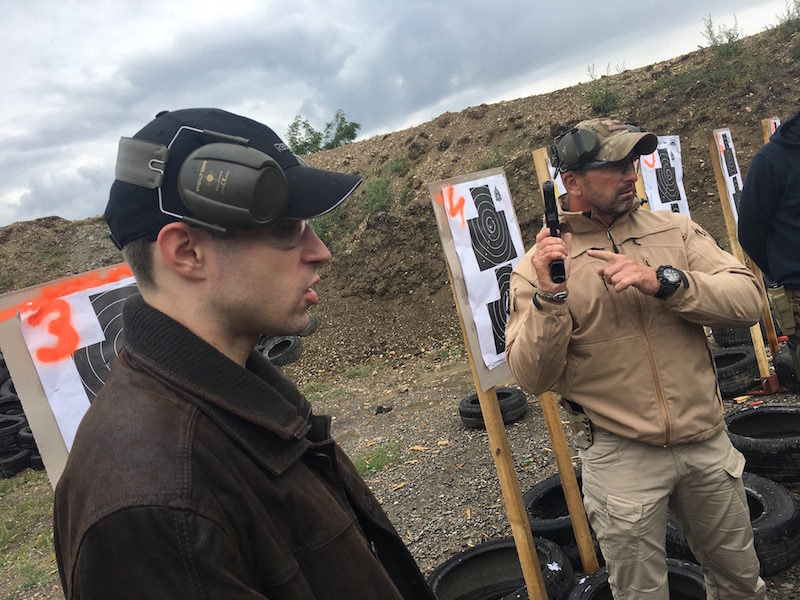 Die Übersetzungen sind klar verständlich und man hat sich mittlerweile daran gewöhnt. Gabriel ist auch schon ein Profi in der Kommunikation mit deutschsprachigen Teilnehmern und dem Dolmetscher, so werden Fragen fachkundig und flott beantwortet. Gerne auch mit Witz und Charme, was die Atmosphäre stets auflockert. Generell fühlt sich der Kurs professionell an. Man wird respektvoll behandelt, aber man fühlt sich nicht wie ein bevormundetes Kleinkind. Fehler darf man machen, doch muss man damit rechnen, dass es eine Null Toleranz Politik für falsche Finger auf dem Abzug gibt. Wer den Finger am Abzug hat, wann er nicht soll, wird sofort aufgefordert diesen von dort zu entfernen.
Die Übersetzungen sind klar verständlich und man hat sich mittlerweile daran gewöhnt. Gabriel ist auch schon ein Profi in der Kommunikation mit deutschsprachigen Teilnehmern und dem Dolmetscher, so werden Fragen fachkundig und flott beantwortet. Gerne auch mit Witz und Charme, was die Atmosphäre stets auflockert. Generell fühlt sich der Kurs professionell an. Man wird respektvoll behandelt, aber man fühlt sich nicht wie ein bevormundetes Kleinkind. Fehler darf man machen, doch muss man damit rechnen, dass es eine Null Toleranz Politik für falsche Finger auf dem Abzug gibt. Wer den Finger am Abzug hat, wann er nicht soll, wird sofort aufgefordert diesen von dort zu entfernen.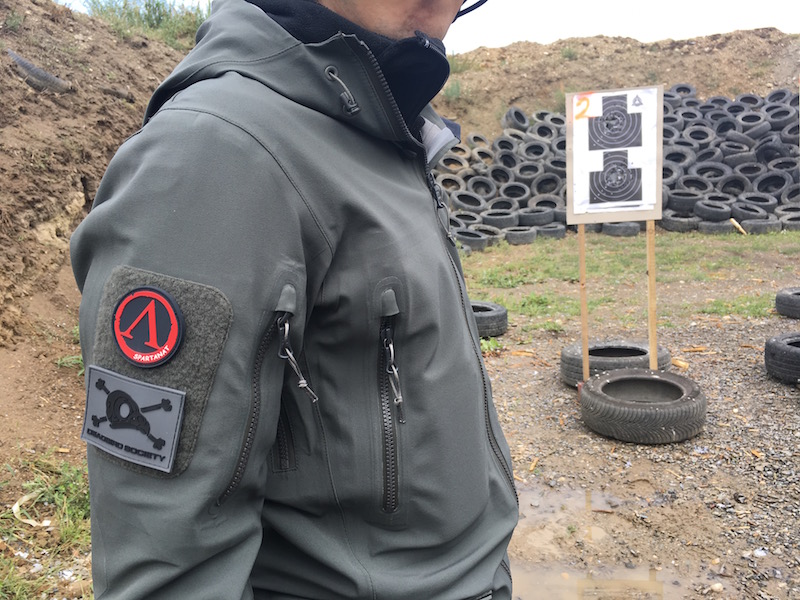 Nach rund 100 Schuss ist es zu Ende. Man fühlt sich am Ende des Kurses sicher. Die Zielscheibe ist durchsiebt und der Jungschütze hat die Überzeugung, nun die Grundlagen seiner Pistole zu beherrschen. Die Finger sind inzwischen von Schmauchspuren etwas schwarz gefärbt. Der Boden ist von leeren Hülsen übersät und es geht zur Nachbesprechung. Gabriel geht erneut auf Schussbilder ein und sagt, ohne mit dem Finger auf Teilnehmer zu deuten, was wie verbessert werden kann. So sehe ich, was ich korrigieren muss, wenn ein Schuss nicht dort landet wo ich ihn haben will.
Nach rund 100 Schuss ist es zu Ende. Man fühlt sich am Ende des Kurses sicher. Die Zielscheibe ist durchsiebt und der Jungschütze hat die Überzeugung, nun die Grundlagen seiner Pistole zu beherrschen. Die Finger sind inzwischen von Schmauchspuren etwas schwarz gefärbt. Der Boden ist von leeren Hülsen übersät und es geht zur Nachbesprechung. Gabriel geht erneut auf Schussbilder ein und sagt, ohne mit dem Finger auf Teilnehmer zu deuten, was wie verbessert werden kann. So sehe ich, was ich korrigieren muss, wenn ein Schuss nicht dort landet wo ich ihn haben will. 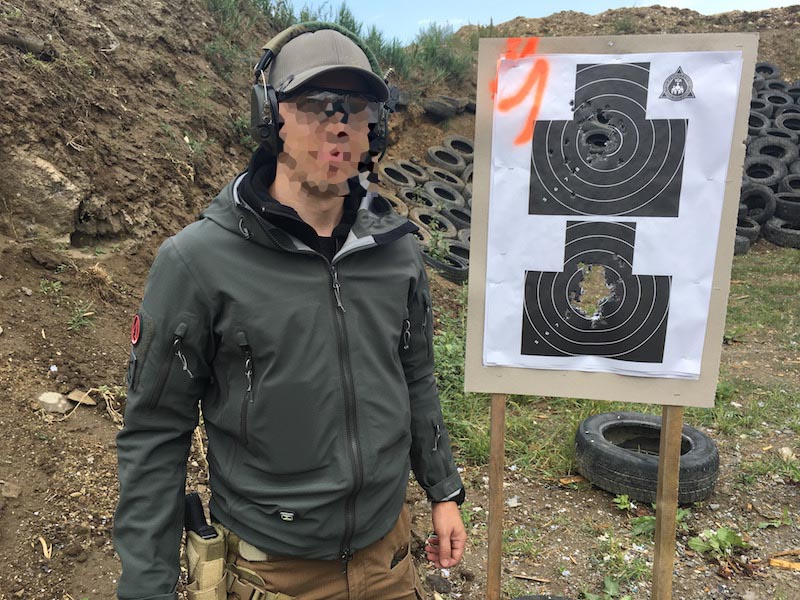 Nun gibt es die Gelegenheit Fotos zu machen, sagt Gabriel. Gesagt getan und auch ich lasse mich mit meiner Zielscheibe ablichten. Anmerkung, meine ist die untere. Ein bisschen Stolz fühle ich mich schon, ist das Trefferbild doch weit besser als ich anfänglich befürchtet hatte. Ich dachte, meine Zielscheibe würde wie von einer Schrotflinte getroffen, weit gestreut, aussehen. Stattdessen ging doch sehr viel in die Mitte. Das macht mir klar, dass es an Gabriel und seinem Instruktorenteam liegen muss. Sie haben mir geholfen mich verstehen zu lassen, wie man mit einer Pistole umgeht und ein gutes Trefferbild zu bekommen. Zum Schluss des TCA Grundkurses Pistole hole ich mir noch mein Zertifikat ab und lausche den Ankündigungen von weiteren möglichen Terminen, die der Kursteilnehmer nun wahrnehmen kann.
Nun gibt es die Gelegenheit Fotos zu machen, sagt Gabriel. Gesagt getan und auch ich lasse mich mit meiner Zielscheibe ablichten. Anmerkung, meine ist die untere. Ein bisschen Stolz fühle ich mich schon, ist das Trefferbild doch weit besser als ich anfänglich befürchtet hatte. Ich dachte, meine Zielscheibe würde wie von einer Schrotflinte getroffen, weit gestreut, aussehen. Stattdessen ging doch sehr viel in die Mitte. Das macht mir klar, dass es an Gabriel und seinem Instruktorenteam liegen muss. Sie haben mir geholfen mich verstehen zu lassen, wie man mit einer Pistole umgeht und ein gutes Trefferbild zu bekommen. Zum Schluss des TCA Grundkurses Pistole hole ich mir noch mein Zertifikat ab und lausche den Ankündigungen von weiteren möglichen Terminen, die der Kursteilnehmer nun wahrnehmen kann.
Guter Kurs, solider Fortschritt
Am gleichen Tag, soll noch ein Aufbaukurs für die Pistole stattfinden. Da wir den ersten erfolgreich abgeschlossen haben, darf ich diesen zweiten nun ebenfalls besuchen. Es hatte mich gepackt und daher will ich ihn ebenfalls gleich machen.
Eine Stunde Zeit liegt zwischen den Kursen. Zeit genug für eine Mittagspause, man konnte sich was zum Essen holen von einem Stand, welcher nicht unweit der Anlage bei Bratislava zu finden ist. Toiletten und ein überdachtes Hauptgebäude zum gemütlichen Speisen lassen auch da keine Wünsche offen. Das Wetter hat sich ebenfalls verbessert. Mit der Nervosität sind auch die Wolken verflogen, die Sonne zeigt sich am Nachmittag in strahlender Pracht. 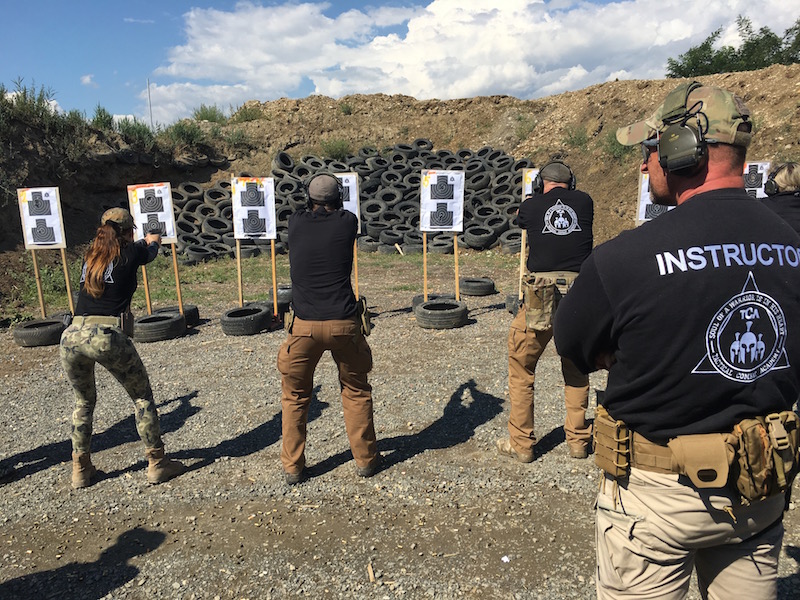 Im zweiten Kurs ging es verstärkt um das Nachladen, das Schießen auf mehrere Ziele und auch ein bisschen Bewegung. Die Teilnehmer wechselt vom ersten Kurs her etwas. Manche reisten zufrieden ab, neue Teilnehmer, die ein andermal den ersten Kur absolviert hatten, kamen hinzu. Manche mussten den Kurs wiederholen, um sicherer in der Bewegung zu werden, andere, wie ich, haben den Aufbau-Kurs zum ersten Mal besucht. Trainer Gabriel erklärt wieder kurz, teilt die Gruppen ein, dann der Safety Drill, und ehe man sich versieht, steht man wieder auf einer Linie und gibt seine Schüsse auf die Zielscheibe ab.
Im zweiten Kurs ging es verstärkt um das Nachladen, das Schießen auf mehrere Ziele und auch ein bisschen Bewegung. Die Teilnehmer wechselt vom ersten Kurs her etwas. Manche reisten zufrieden ab, neue Teilnehmer, die ein andermal den ersten Kur absolviert hatten, kamen hinzu. Manche mussten den Kurs wiederholen, um sicherer in der Bewegung zu werden, andere, wie ich, haben den Aufbau-Kurs zum ersten Mal besucht. Trainer Gabriel erklärt wieder kurz, teilt die Gruppen ein, dann der Safety Drill, und ehe man sich versieht, steht man wieder auf einer Linie und gibt seine Schüsse auf die Zielscheibe ab. 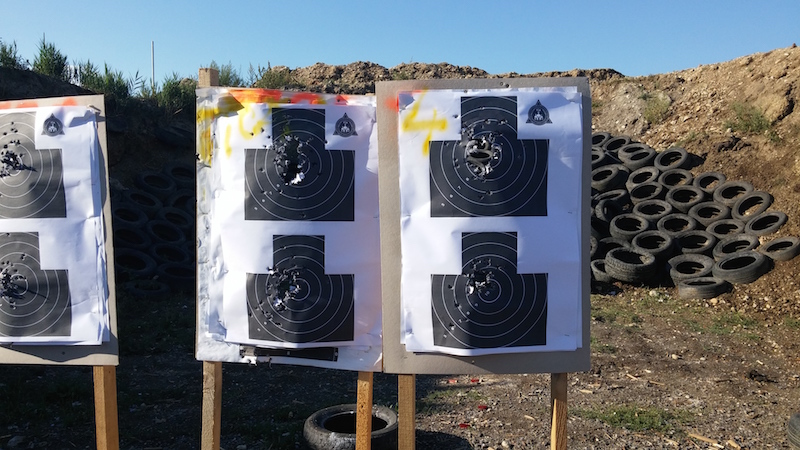 Mit dem neuen Element Bewegung verschlechtert sich mein Trefferbild. Die völlig neue Dynamik versetzt mich und andere Schützen in Stress. Die Anforderungen im zweiten Kurs waren rasant gestiegen – und gleichzeitig sinkt gegen Ende des Tages meine Konzentration. Dennoch landen die Kugeln im schwarzen Feld, also war ich zufrieden.
Mit dem neuen Element Bewegung verschlechtert sich mein Trefferbild. Die völlig neue Dynamik versetzt mich und andere Schützen in Stress. Die Anforderungen im zweiten Kurs waren rasant gestiegen – und gleichzeitig sinkt gegen Ende des Tages meine Konzentration. Dennoch landen die Kugeln im schwarzen Feld, also war ich zufrieden. Gabriel und die anderen Instruktoren wirken im zweiten Kurs etwas entspannter. Stets unter sicherer Beobachtung, gibt es viel weniger Zwischenrufe an oder Korrekturen für einzelne Teilnehmer. Die Trainer wirkten fast zufrieden, wenn alle annähernd zeitgleich mit einem Drill fertig werden und auf Details achten. Wie etwa beim Umgebungscheck: da hält Gabriel seine Hand hoch und zeigte eine Zahl, welche er nachher abfrag. Immer wieder macht der Chefinstruktor kleine Tests um zu sehen, ob die Teilnehmer aufpassen und mitdenken. Dies spornt natürlich an und hält einen wachsam.
Gabriel und die anderen Instruktoren wirken im zweiten Kurs etwas entspannter. Stets unter sicherer Beobachtung, gibt es viel weniger Zwischenrufe an oder Korrekturen für einzelne Teilnehmer. Die Trainer wirkten fast zufrieden, wenn alle annähernd zeitgleich mit einem Drill fertig werden und auf Details achten. Wie etwa beim Umgebungscheck: da hält Gabriel seine Hand hoch und zeigte eine Zahl, welche er nachher abfrag. Immer wieder macht der Chefinstruktor kleine Tests um zu sehen, ob die Teilnehmer aufpassen und mitdenken. Dies spornt natürlich an und hält einen wachsam. 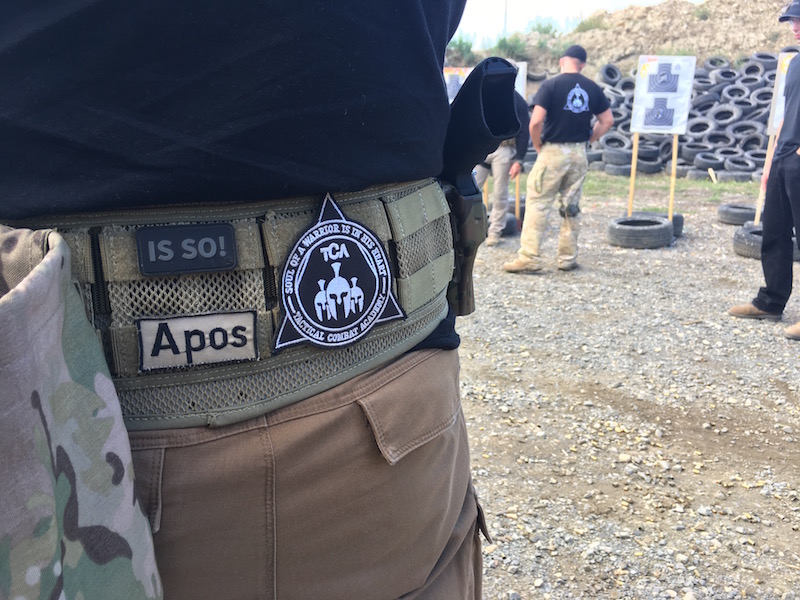 Am Ende des zweiten Kurses und damit dieses Tages bin ich erledigt. Die Hände schmerzen vom Rückstoß und ständigem schlagen auf den Magazinboden beim Laden. Aber ich bin genau so zufrieden. Und ich bin glücklich endlich einen vernünftigen Kurs besucht zu haben, nicht nur um selbst scharf zu schießen, sondern auch um den richtigen Umgang und das sichere Verhalten mit einer Waffe zu erlernen.
Am Ende des zweiten Kurses und damit dieses Tages bin ich erledigt. Die Hände schmerzen vom Rückstoß und ständigem schlagen auf den Magazinboden beim Laden. Aber ich bin genau so zufrieden. Und ich bin glücklich endlich einen vernünftigen Kurs besucht zu haben, nicht nur um selbst scharf zu schießen, sondern auch um den richtigen Umgang und das sichere Verhalten mit einer Waffe zu erlernen.
Nach dem Kurs hab ich noch beim Merchandise Stand zugeschlagen und mir zum Zeugnis meinen Patch gegönnt. Und ich sage an dieser Stelle: Danke an die TCA, an Gabriel und sein Instruktorenteam. Es hat Spass gemacht, ich habe sehr viel gelernt und habe mich dabei stets sicher gefühlt. Ich kann es kaum erwarten erneut einen Kurs dort zu besuchen und befürchte, dass für mich eine Tür aufgeschlagen wurde – zu einem weiteren Hobby.
Wer sich für Kurse interessiert, kann das gesamte TCA Programm 2020 HIER anschauen und erhält genaue Informationen. Anmeldung und Anfragen auch direkt über die Seite der TCA.
Die TACTICAL COMBAT ACADEMY im Internet: www.tcacademy.at
SPARTANAT ist das Online-Magazin für Military News, Tactical Life, Gear & Reviews.
Schickt uns eure News: [email protected]
Werbung
Hol Dir den wöchentlichen SPARTANAT-Newsletter.
Dein Bonus: das gratis E-Book von SPARTANAT.


